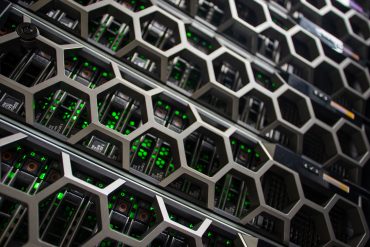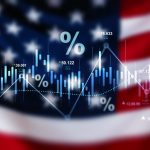
- AI Hardware
- AI Infrastructure
- Cloud & Infra
Corporate AI Hardware Spending Hits Record High
6 minute read

Corporate AI hardware spending reaches record levels as companies rush to build computing infrastructure for artificial intelligence deployment
Key Takeaways
- Hardware investment jumps 86.4% while GDP growth slows to 1.2%: Computer equipment spending surged in the first half of 2025, yet broader economic benefits remain limited as productivity gains lag behind capital investment.
- AI-exposed industries see revenue growth nearly quadruple since 2022: Companies integrating artificial intelligence report measurable returns and accelerated revenue per worker, with Goldman Sachs projecting $7 trillion in global GDP impact over the next decade.
- Import dependency undermines domestic manufacturing benefits: Nearly 60% increase in computer imports over the past year contributed only 0.03% to GDP growth, while domestic software investment added 0.26%.
Introduction
Artificial intelligence investments are reshaping corporate spending patterns, yet the technology’s promise of transformative economic growth remains largely unrealized. Business investment in computer hardware and software expanded at a 6.1% rate during the first half of 2025, driven primarily by companies preparing for an AI-driven future.
The disconnect between investment enthusiasm and economic output highlights the complexity of translating technological advancement into measurable productivity gains. While companies pour resources into AI infrastructure, real GDP growth has decelerated to just 1.2% annualized, raising questions about the timeline for artificial intelligence to deliver on its economic potential.
Key Developments
Computer equipment spending has accelerated dramatically, with an 86.4% annualized increase in the first half of 2025 according to Capital Economics. Software investment complemented this surge with an 18% rise, indicating broad-based corporate commitment to AI-related technologies.
The investment wave extends beyond traditional technology companies. Manufacturing firms deploy AI-driven robotics and predictive maintenance systems to improve efficiency and reduce downtime. Healthcare organizations integrate artificial intelligence into diagnostics, drug discovery, and personalized medicine applications.
Financial services companies have embraced AI for risk assessment, fraud detection, and algorithmic trading. This sector-wide adoption suggests artificial intelligence has moved from experimental technology to essential business infrastructure across multiple industries.
Market Impact
Import data reveals the global nature of AI infrastructure investment. Imports of computers and peripherals climbed nearly 60% over the past year, with most hardware sourcing coming from overseas suppliers rather than domestic manufacturers.
This import dependency creates an economic paradox. While companies invest heavily in AI capabilities, the immediate GDP contribution from domestic computer and electronic product manufacturing remains minimal at 0.03% for first-quarter growth.
Labor productivity presents mixed signals, expanding at a 2.4% annualized pace in the second quarter due to slower employment growth. However, annual productivity growth has actually decelerated to 1.2%, suggesting that hardware investments have not yet translated into measurable efficiency improvements.
Strategic Insights
The current investment pattern differs markedly from previous technology booms. During the late 1990s productivity surge, multifactor productivity gains drove economic expansion beyond simple capital or labor inputs. Today’s artificial intelligence deployment lacks similar broad-based productivity acceleration.
Companies are fundamentally restructuring their operations around AI capabilities. Organizations merge support and customer success functions into unified engagement models, while shifting toward outcome-aligned pricing strategies that reflect AI-driven value delivery.
The talent market reflects this transformation, with AI-exposed jobs experiencing faster skill changes and rising wage premiums. Workers with artificial intelligence expertise command higher compensation, suggesting that technology augments rather than replaces human capabilities in most applications.
Expert Opinions and Data
Capital Economics analysts suggest that some hardware purchases may stem from companies buying ahead of potential tariffs rather than genuine AI demand. This purchasing behavior could artificially inflate investment figures while masking the true scope of artificial intelligence adoption.
According to a16z, current software investment growth remains below historical averages at nearly 10%, with research and development spending stagnant over the past year. Capital Economics emphasizes that significant productivity gains will require substantial increases in both software and R&D investment.
Goldman Sachs projects artificial intelligence could boost global GDP by $7 trillion over the next decade, while McKinsey estimates annual growth between $17.1 and $25.6 trillion. However, more conservative analyses suggest a modest 1% GDP increase over ten years for the United States, reflecting realistic adoption rates and task automation limitations.
Revenue growth in AI-exposed industries has nearly quadrupled since 2022, indicating substantial financial returns from artificial intelligence investments. This performance demonstrates that while macroeconomic impacts remain limited, individual companies and sectors are capturing measurable value from AI deployment.
Conclusion
The artificial intelligence investment boom has created a complex economic landscape where corporate spending surges while broader productivity gains remain elusive. Companies continue expanding AI capabilities across industries, from manufacturing to healthcare to financial services, yet the technology’s macroeconomic impact has not matched the scale of capital deployment.
The current phase represents an infrastructure-building period where businesses establish the foundation for future AI applications. While import dependency limits immediate domestic economic benefits, the transformation of business models and workforce skills suggests longer-term structural changes are underway that may eventually deliver the productivity improvements that current investment levels anticipate.








